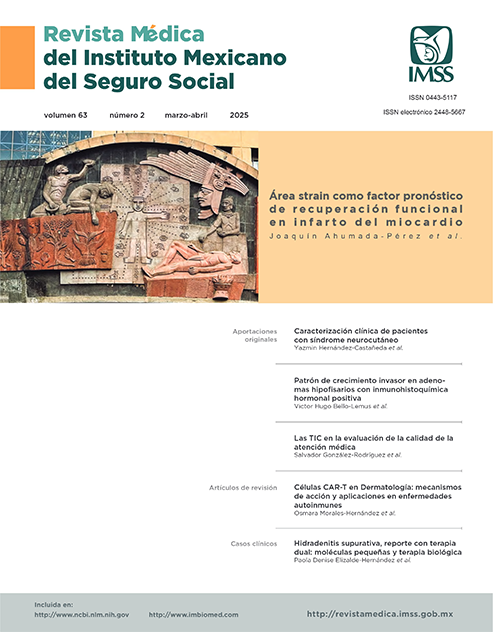Elevated neutrophil-lymphocyte ratioand delayed graft function
Main Article Content
Keywords
Kidney Transplantation, Acute Kidney Injury, Neutrophils, Tissue Donors
Abstract
Background: Delayed graft function (DGF) is a significant complication in kidney transplantation, adversely affecting graft and recipient survival. Therefore, it is important to establish tools that help predict this condition. The elevation of the neutrophil-to-lymphocyte ratio (NLR) has been studied as a predictor of DGF, with the premise that its increase is associated with systemic inflammation and, consequently, DGF.
Objective: To analyze the association between an elevated NLR in the preoperative period and delayed graft function in kidney transplant recipients.
Materials and methods: A prospective, observational, analytical, and longitudinal study. The sample included all patients admitted to the Nephrology Transplant Service at Hospital de Especialidades No. 1, Centro Médico Nacional Bajío, in 2023.
Results: We found that an NLR greater than 3.5 in the preoperative period of patients undergoing kidney trans[1]plantation had 80% specificity and 28% sensitivity, compared to patients with an NLR of 3.5 or lower.
Conclusions: There is no association between an elevated NLR in the preoperative period and delayed kidney graft function after transplantation. However, it may be associated with other risk factors, as demonstrated in the multivariate analysis, which revealed that donor acute kidney injury increased the likelihood of developing DGF by almost 200%.
References
Villalvazo P, Carriazo S, Martin-Cleary C, et al., Aguascalientes: one of the hottest chronic kidney disease (CKD) hotspots in Mexico and a CKD of unknown aetiology mystery to be solved. Clin Kidney J. 2021;14(11):2285-94. Disponible en: https://academic.oup.com/ckj/article/14/11/2285/6321889
GBD compare. Institute for Health Metrics and Evaluation. Disponible en: https://vizhub.healthdata.org/gbd-compare/
Agudelo-Botero M, Valdez-Ortiz R, Giraldo-Rodríguez L, et al. Overview of the burden of chronic kidney disease in Mexico: secondary data analysis based on the Global Burden of Disease Study 2017. BMJ Open. 2020;10(3):e035285. Disponible en: https://bmjopen.bmj.com/content/10/3/e035285
Centro Nacional de Trasplantes. BOLETÍN ESTADÍSTICO - INFORMATIVO DEL CENTRO NACIONAL DE TRASPLANTES BEI-CENATRA. 2020;V(2). Disponible en: http://www.gob.mx/cms/uploads/attachment/file/646854/BEI-CENATRA_Vol5_Num2_FINAL_WEB_17jun21.pdf
Álvarez-Rangel LE, Cruz-Santiago J, Meza-Jiménez L, et. al, Modificación de la calidad de vida relacionada con la salud en receptores de trasplante renal. Revista Médica del Instituto Mexicano del Seguro Social. 2015;53(S1):S66-S73.
Abdelaziz EM, Darwish MM, Taie AG, et al. Predictors of post-kidney transplantation complications among Egyptian recipients—1-year follow-up. Egypt J Intern Med. 2024;36(1). Disponible en: http://dx.doi.org/10.1186/s43162-024-00332-6
Sawinski D, Poggio ED. Introduction to kidney transplantation: Long-term management challenges. Clin J Am Soc Nephrol. 2021;16(8):1262-3. Disponible en: https://pubmed.ncbi.nlm. nih.gov/33692119/
Rosso G, Salvadori M. Infective complications in the renal transplant recipients. G Clin Nefrol Dial. 2024;36(1):1-6. Disponible en: https://journals.aboutscience.eu/index.php/ gcnd/article/view/3017
Massicotte-Azarniouch D, Detwiler RK, Hu Y, et al. Infections following kidney transplantation after exposure to immune-suppression for treatment of glomerulonephritis. Am J Kidney Dis. 2024;83(6):784-793.e1. Disponible en: http://dx.doi. org/10.1053/j.ajkd.2023.10.016
Kaul DR, Vece G, Blumberg E, et al. Ten years of donor-derived disease: A report of the disease transmission advisory committee. Am J Transplant. 2021;21(2):689-702. Disponible en: https://onlinelibrary.wiley.com/doi/pdf/10.1111/ajt.16178
Yao Z, Kuang M, Li Z. Global trends of delayed graft function in kidney transplantation from 2013 to 2023: a bibliometric analysis. Ren Fail. 2024;46(1). Disponible en: http://dx.doi.org/10.1080/0886022x.2024.2316277
Ye BM, Hyeon JM, Kim, et al. Analysis of risk factors for delayed graft function after kidney transplantation. Transplant Proc. 2022;54(8):2154-8. Disponible en: https://pubmed.ncbi. nlm.nih.gov/36114044/
Mezzolla V, Pontrelli P, Fiorentino M, et al. Emerging biomarkers of delayed graft function in kidney transplantation. Transplant Rev (Orlando). 2021;35(4):100629. Disponible en: http://dx.doi.org/10.1016/j.trre.2021.100629
Sweet AL, Connelly CR, Dewey EN, et al. The effect of perfusate temperature on delayed graft function in deceased donor renal transplantation. Prog Transplant. 2023;33(4). Disponible en: https://pubmed.ncbi.nlm.nih.gov/37964564/
Arias-Cabrales CE, Pérez-Sáez MJ, Redondo-Pachón D, et al. Relevance of KDPI value and acute rejection on kidney transplant outcomes in recipients with delayed graft function - a retrospective study. Transpl Int. 2020;33(9):1071-7. Disponible en: http://dx.doi.org/10.1111/tri.13654
Santarsiero D, Aiello S. The complement system in kidney transplantation. Cells. 2023;12(5):791. Disponible en: http://dx.doi.org/10.3390/cells12050791
Nieuwenhuijs-Moeke GJ, Pischke SE, Berger SP, et al. Ischemia and reperfusion injury in kidney transplantation: Relevant mechanisms in injury and repair. J Clin Med. 2020;9(1):253. Disponible en: https://www.mdpi.com/2077-0383/9/1/253
Liao J, Wei D, Sun C, et. al. Prognostic value of the combination of neutrophil-to-lymphocyte ratio, monocyte-to-lymphocyte ratio and platelet-to-lymphocyte ratio on mortality in patients on maintenance hemodialysis. BMC Nephrol. 2022;23(1). Disponible en: http://dx.doi.org/10.1186/s12882-022-03020-1
Song M, Graubard BI, Rabkin CS, et al. Neutrophil-to-lymphocyte ratio and mortality in the United States general population. Sci Rep. 2021;11(1):1-9. Disponible en: https://www. nature.com/articles/s41598-020-79431-7
Zahorec R. Neutrophil-to-lymphocyte ratio, past, present and future perspectives. Bratisl Lek Listy. 2021;122(07):474-88. Disponible en: https://pubmed.ncbi.nlm.nih.gov/34161115/
Li C, Yu Y, Zhu S, et al. The emerging role of regulated cell death in ischemia and reperfusion-induced acute kidney injury: current evidence and future perspectives. Cell Death Discov. 2024;10(1):1-10. Disponible en: https://www.nature.com/ articles/s41420-024-01979-4
Wu J, Zhang F, Zheng X, et al. Identification of renal ischemia reperfusion injury subtypes and predictive strategies for delayed graft function and graft survival based on neutrophil extracellular trap-related genes. Front Immunol. 2022;13. Disponible en: http://dx.doi.org/10.3389/fimmu.2022.1047367
Kolonko A, Dwulit T, Skrzypek M, et al. Potential utility of neutrophil-to-lymphocyte, platelet-to-lymphocyte, and neutrophil, lymphocyte, and platelet ratios in differential diagnosis of kidney transplant acute rejection: A retrospective, propensity score matched analysis. Ann Transplant. 2022;27:e937239-1. Disponible en: http://dx.doi.org/10.12659/aot.937239
Halazun KJ, Marangoni G, Hakeem A, et al. Elevated preoperative recipient neutrophil-lymphocyte ratio is associated with delayed graft function following kidney transplantation. Transplant Proc. 2013;45(9):3254-7. Disponible en: https://pubmed. ncbi.nlm.nih.gov/24182795/
Ergi̇n G. High neutrophil-to-lymphocyte ratio predicts acute allograft rejection in kidney transplantation: a retrospective study. Turk J Med Sci. 2019;49(2):525-30. Disponible en: http://dx.doi.org/10.3906/sag-1811-41


